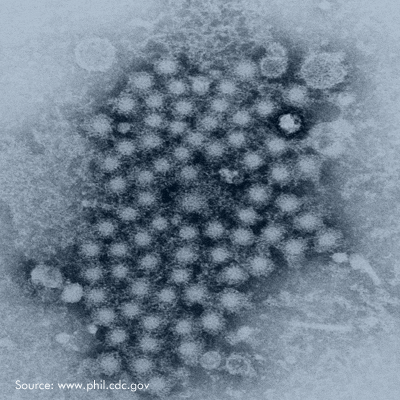
Get A Testing Quote
Hepatitis A Virus
| Virus | Hepatitis A Virus |
| Structure | Non-enveloped |
| Family | Picornaviridae |
| Host(s) | Humans |
| Disease(s) Caused | Acute liver disease |
| Symptoms | Juandice, nausea, fever, lethargy, abdominal pain |
| Potential Complications | Acute liver failure |
| Transmission Mode | Fecal-Oral: Person-to-person contact; foodborne; waterborne; contaminated fomites |
| Sites of Community Outbreaks | Daycare centers; restaurants |
Importance of Hepatitis A Virus
Hepatitis A virus is one of the five major hepatitis viruses, along with B, C, D, and E. Hepatitis viruses A and E are spread via the fecal-oral route, unlike B, C, and D, which are bloodborne pathogens. Upon ingestion of infectious hepatitis A virus, an incubation period follows ranging from 10 to 50 days. Infected persons may exhibit symptoms, such as nausea/vomiting, abdominal pain, anorexia, and headache. Some develop the telltale yellowing of the skin and eyes (jaundice) associated with damage caused to the liver during illness. However, a number of infected persons remain asymptomatic or do not develop jaundice; this tendency has been correlated to age in several outbreak studies (3).
Outbreaks of hepatitis A virus illness have been associated with settings characterized by a high frequency of person-to-person contact including hospitals, daycare centers, and institutional centers (4, 6, 11). A number of outbreaks have also been associated with restaurants, water, shellfish, and crops (2, 12).
The Importance of Disinfection: Survival of Hepatitis A Virus on Surfaces and Transmission Potential via Fomites
Following viral replication in hepatocytes, hepatitis A virus is released via the bile duct into the intestinal tract and into the environment with fecal excrement. Infected persons can shed anywhere from 5-log10 to 11-log10 viruses per gram of feces (5). Deposition of the virus onto the hands or fomites can occur with the release of feces with survival and subsequent transfer in the environment dependent on temperature, humidity, and other factors. In contrast to related enteroviruses, such as poliovirus, hepatitis A remained active under conditions of low relative humidity when dried on stainless steel disks in the presence of fecal material with substantial reductions observed at high relative humidities of 80 ± 5%; lower temperatures facilitated enhanced survival similar to poliovirus-1 (8). A substantial loss of hepatitis A viral infectivity follows within one hour of inoculation onto hands and stainless steel disks; however, transfer efficiency from fingerpads to disks was still demonstrated after four hours (9).
The implications of hepatitis A virus transfer from hands are of great importance, particularly when the objects are food items that will not be cooked or heat-treated, such as raw produce. Approximately 9% of hepatitis A viruses inoculated onto the fingerpads of volunteers were transferred to lettuce (representing from 1 to 1,300 infectious viral units), demonstrating a possible scenario for the initiation of infection in potential human hosts (1). However, these transfer efficiencies were drastically reduced by the use of topical agents prior to the handling of the lettuce.
The tough and hardy structure of hepatitis A virus grants a unique resistance to inactivation by many chemical disinfectants. Following a 1-minute contact time, only 2% glutaraldehyde, a quaternary ammonium compound formulation containing 23% HCl, and sodium hypochlorite (>5,000 ppm free chlorine) reduced dried film hepatitis A viral titers by > 3-log10 (>99.9%), where phenolics, iodides, alcohols, and various acids proved ineffective (7). This resistance has also been demonstrated for a number of handwashing agents. A number of formulations have proven more efficacious against poliovirus-1 than hepatitis A virus, although infectious viruses remaining on the hands after washing were highlighted as an ongoing issue of concern (10).
References
- Bidawid, S., J. Farber, and S. Sattar. 2000. Contamination of foods by food handlers: experiments on hepatitis A virus transfer to food and its interruption. 66: 2759-2763.
- Bowen, G. and M. McCarthy. 1983. Hepatitis A associated with a hardware store water fountain and a contaminated well in Lancaster County, Pennsylvania. American Journal of Epidemiology. 117: 695-705.
- Cuthbert, J. 2001. Hepatitis A: old and new. Clinical Microbiology Reviews. 14: 38-58.
- Doebbling, B., N. Li, and R. Wenzel. 1993. An outbreak of hepatitis A among health care workers: risk factors for transmission. American Journal of Public Health. 83: 1679-1684.
- Farthing, M. 1989. Viruses and the Gut. Published by Smith, Kline, & French, Garden City, United Kingdom.
- Matthew, E. et al. 1973. A major epidemic of infectious hepatitis in an institution for the mentally retarded. American Journal of Epidemiology. 98: 199-215.
- Mbithi, J., S. Springthorpe, and S. Sattar. 1990. Chemical disinfection of hepatitis A on environmental surfaces. Applied and Environmental Microbiology. 56: 3601-3604.
- Mbithi, J., S. Springthorpe, and S. Sattar. 1991. Effect of relative humidity and air temperature in survival of hepatitis A virus on environmental surfaces. Applied and Environmental Microbiology. 57:1394-1399.
- Mbithi, J., S. Springthorpe, J. Boulet, and S. Sattar. 1992. Survival of hepatitis A virus on human hands and its transfer on contact with animate and inanimate surfaces. Journal of Clinical Microbiology. 30:757-763.
- Mbithi, J., S. Springthorpe, and S. Sattar. 1993. Comparative in vivo efficiencies of hand-washing agents against hepatitis A virus (HM-175) and poliovirus type 1(Sabin). Applied and Environmental Microbiology. 57:1394-1399.
- Vernon, A., C. Schable, and D. Francis. 1982. A large outbreak of hepatitis A in a day-care center: association with non-toilet-trained children and persistence of IgM antibiody to hepatitis A virus. American Journal of Epidemiology. 115: 325-331.
- Wheeler, C. et al. 2005. An outbreak of hepatitis A associated with green onions. The New England Journal of Medicine. 353: 890-897.
Share

